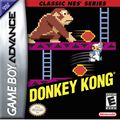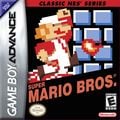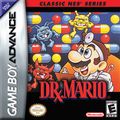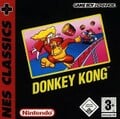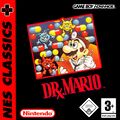Classic NES Series: Difference between revisions
Tags: Mobile edit Advanced mobile edit |
mNo edit summary |
||
| (16 intermediate revisions by 4 users not shown) | |||
| Line 2: | Line 2: | ||
{{distinguish|Classics|[[Nintendo Classics]] (also referred to as Classic Series)}} | {{distinguish|Classics|[[Nintendo Classics]] (also referred to as Classic Series)}} | ||
{{redirect|NES Classics|the {{wp|Adobe Flash}} advergame|[[NES Classics (Flash game)]]}} | {{redirect|NES Classics|the {{wp|Adobe Flash}} advergame|[[NES Classics (Flash game)]]}} | ||
{{game infobox | |||
|title=Classic NES Series | |||
|image=[[File:ClassicNESSeries_promoimage.jpg|250px]] | |||
|developer=[[Nintendo]] | |||
|publisher=Nintendo | |||
|release=2004 | |||
|release2='''''Donkey Kong:'''''<br>{{flag list|Japan|February 14, 2004|USA|June 7, 2004|Europe|July 9, 2004}} '''''Dr. Mario:'''''<br>{{flag list|Japan|May 21, 2004|USA|October 25, 2004|Europe|January 7, 2005}} '''''Mario Bros.:'''''<br>{{flag list|Japan|May 21, 2004}} '''''Super Mario Bros.:'''''<br>{{flag list|Japan|February 14, 2004|USA|June 7, 2004|Europe|July 9, 2004}} '''''Super Mario Bros.: The Lost Levels:'''''<br>{{flag list|Japan|August 10, 2004}} '''''Wrecking Crew:'''''<br>{{flag list|Japan|May 21, 2004}} | |||
|languages={{languages|en=y}} | |||
|genre= | |||
|modes=Single player, Multiplayer | |||
|platforms=[[Game Boy Advance]] | |||
|format={{format|gba=1}} | |||
|input={{input|gba=1}} | |||
}} | |||
{{redirect|Famicom Mini|the mini console|[[Classics#Nintendo Classic Mini: Family Computer|Nintendo Classic Mini: Family Computer]]}} | |||
The '''''Classic NES Series''''', known as the '''''NES Classics''''' in Europe and Australia, and as '''''Famicom Mini''''' in Japan, is a series of video games for the [[Game Boy Advance]] released in 2004 and 2005. All games are emulated versions of classic [[Family Computer|Famicom]]/[[Nintendo Entertainment System|NES]] video games, including six games of the [[Super Mario (franchise)|''Super Mario'' franchise]]. They are mostly unchanged from the originals, but features such as multiplayer using the [[Game Boy Advance#Game Link Cable|link cable]] or [[Game Boy Advance#Wireless Adaptor|wireless adapter]] (only if the original game included multiplayer) and save functions for high scores and custom levels were added in certain cases. The resolution of the games was altered to fit the GBA screen, making the graphics look "squished." | The '''''Classic NES Series''''', known as the '''''NES Classics''''' in Europe and Australia, and as '''''Famicom Mini''''' in Japan, is a series of video games for the [[Game Boy Advance]] released in 2004 and 2005. All games are emulated versions of classic [[Family Computer|Famicom]]/[[Nintendo Entertainment System|NES]] video games, including six games of the [[Super Mario (franchise)|''Super Mario'' franchise]]. They are mostly unchanged from the originals, but features such as multiplayer using the [[Game Boy Advance#Game Link Cable|link cable]] or [[Game Boy Advance#Wireless Adaptor|wireless adapter]] (only if the original game included multiplayer) and save functions for high scores and custom levels were added in certain cases. The resolution of the games was altered to fit the GBA screen, making the graphics look "squished." | ||
In [[Japan]], [[Nintendo]] released 30 games in three series in total, while North America and Europe only saw 12 games in two series. Several NES games were also released in North America on [[e-Reader]] cards, though. The Japanese releases feature game packaging almost identical to the original packaging for the Famicom. | In [[Japan]], [[Nintendo]] released 30 games in three series in total, while North America and Europe only saw 12 games in two series. Several NES games were also released in North America on [[e-Reader]] cards, though. The Japanese releases feature game packaging almost identical to the original packaging for the Famicom. | ||
{{br|toc=1}} | |||
==''Super Mario'' games== | ==''Super Mario'' games== | ||
{|class="wikitable sortable"width=100% | |||
|- | |||
!width=15%|Game | |||
* | !width=15%|Japan release date | ||
!width=15%|North America release date | |||
!width=15%|Europe release date | |||
!width=40%|Version differences | |||
|- | |||
|''[[Donkey Kong (game)|Donkey Kong]]'' | |||
|2004 / 02 / 14 | |||
|2004 / 06 / 07 | |||
|2004 / 07 / 09 | |||
| | |||
|- | |||
* | |''[[Dr. Mario (game)|Dr. Mario]]'' | ||
*''Mario Bros.'' | |2004 / 05 / 21 | ||
|2004 / 10 / 25 | |||
**The counters on top are moved to the upper edge, and the text font is changed to require fewer pixels. | |2005 / 01 / 07 | ||
| | |||
*The two-player option is removed from the title screen. To access it, player 1 has to press the {{button|gba|L}} and {{button|gba|R}} buttons together to open the menu and select linked play. Player 2 can then download the game onto their system. | |||
*The edges are heavily cropped (even more so than in ''[[Nintendo Puzzle Collection]]''), especially on top and bottom. | |||
|- | |||
|''[[Mario Bros. (game)|Mario Bros.]]'' | |||
|2004 / 05 / 21 | |||
|N/A | |||
|N/A | |||
|The "2 Player Game A" and "2 Player Game B" choices are removed from the title screen. The method to access them is the same as for ''Dr. Mario'' except the menu is in Japanese. | |||
|- | |||
|''[[Super Mario Bros.]]'' | |||
|2004 / 02 / 14;<br>2005 / 09 / 13 ([[Happy! Mario 20th|20th anniversary]]) | |||
|2004 / 06 / 07 | |||
|2004 / 07 / 09 | |||
| | |||
*The counters on top are moved to the upper edge, and the text font is changed to require fewer pixels. | |||
*This release is almost identical to the "Hot Mario! Campaign" version that was awarded to 3,000 Japanese contestants in a drawing that ended on January 15, 2004. That version is unable to connect with the wireless adapter. | |||
|- | |||
|[[Super Mario Bros.: The Lost Levels|''Super Mario Bros. 2'' (''Super Mario Bros.: The Lost Levels'')]] | |||
|2004 / 08 / 10 | |||
|N/A | |||
|N/A | |||
| | |||
*Holding the {{button|gba|A}} or {{button|gba|B}} while the Game Boy Advance logo is shown will trigger the [[Family Computer Disk System]]'s "Please Set Disk Card" screen. | |||
*The counters on top are moved to the upper edge, and the text font is changed to require fewer pixels. | |||
*A pause menu is available during gameplay, with options to Continue, Reset, Save High Score, and Sleep Mode. | |||
*After beating [[World 8-4 (Super Mario Bros.: The Lost Levels)|World 8-4]], the message "ハイスコアとスタすうを セーブしまた ボタンをおしてください" is shown. | |||
|- | |||
|''[[Wrecking Crew]]'' | |||
|2004 / 05 / 21 | |||
|N/A | |||
|N/A | |||
| | |||
|} | |||
==Famicom Mini Collection== | ==Famicom Mini Collection== | ||
| Line 47: | Line 95: | ||
Famicom Mini Wrecking Crew cover.jpg|''[[Wrecking Crew|Famicom Mini: Wrecking Crew]]'' | Famicom Mini Wrecking Crew cover.jpg|''[[Wrecking Crew|Famicom Mini: Wrecking Crew]]'' | ||
SMB Famicom Mini Box.jpg|''[[Super Mario Bros.|Famicom Mini: Super Mario Bros.]]'' | SMB Famicom Mini Box.jpg|''[[Super Mario Bros.|Famicom Mini: Super Mario Bros.]]'' | ||
SMB Famicom Mini Box 20th anniversary.jpg|''[[Super Mario Bros.|Famicom Mini: Super Mario Bros.]]'' ([[Happy! Mario 20th|20th anniversary edition]]) | |||
Famicom Mini Super Mario Bros 2J cover.jpg|''[[Super Mario Bros.: The Lost Levels|Famicom Mini: Super Mario Bros. 2]]'' | Famicom Mini Super Mario Bros 2J cover.jpg|''[[Super Mario Bros.: The Lost Levels|Famicom Mini: Super Mario Bros. 2]]'' | ||
Dr.Mario.Famicom Mini front cover.jpg|''[[Dr. Mario (game)|Famicom Mini: Dr. Mario]]'' | Dr.Mario.Famicom Mini front cover.jpg|''[[Dr. Mario (game)|Famicom Mini: Dr. Mario]]'' | ||
| Line 56: | Line 105: | ||
==Names in other languages== | ==Names in other languages== | ||
{{foreign names | {{foreign names | ||
| | |Jpn=ファミコンミニ | ||
| | |JpnR=Famikon Mini | ||
| | |JpnM=Famicom Mini | ||
}} | }} | ||
| Line 68: | Line 117: | ||
**[http://www.nintendo.co.jp/n08/fmk3/index.html Series 3] | **[http://www.nintendo.co.jp/n08/fmk3/index.html Series 3] | ||
**[http://www.nintendo.co.jp/n08/fsmj/index.html ''Super Mario Bros.'' 20th Anniversary] | **[http://www.nintendo.co.jp/n08/fsmj/index.html ''Super Mario Bros.'' 20th Anniversary] | ||
{{Game series}} | {{Game series}} | ||
{{Super Mario games}} | {{Super Mario games}} | ||
{{GBA}} | {{GBA}} | ||
[[de:NES Classics]] | [[de:NES Classics]] | ||
[[Category:Game series]] | [[Category:Game series]] | ||
[[Category:Re-releases]] | [[Category:Re-releases]] | ||
[[Category:Classic NES Series|*]] | [[Category:Classic NES Series|*]] | ||
Revision as of 07:00, February 18, 2025
- Not to be confused with Classics or Nintendo Classics (also referred to as Classic Series).
- "NES Classics" redirects here. For the Adobe Flash advergame, see NES Classics (Flash game).
| Classic NES Series | |
|---|---|
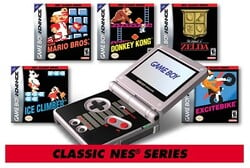
| |
| Developer | Nintendo |
| Publisher | Nintendo |
| Platform(s) | Game Boy Advance |
| Release date | 2004[?]
Donkey Kong:
Dr. Mario: Mario Bros.: Super Mario Bros.: Super Mario Bros.: The Lost Levels: Wrecking Crew: |
| Language(s) | English |
| Mode(s) | Single player, Multiplayer |
| Format | Game Boy Advance: |
| Input | Game Boy Advance:
|
- "Famicom Mini" redirects here. For the mini console, see Nintendo Classic Mini: Family Computer.
The Classic NES Series, known as the NES Classics in Europe and Australia, and as Famicom Mini in Japan, is a series of video games for the Game Boy Advance released in 2004 and 2005. All games are emulated versions of classic Famicom/NES video games, including six games of the Super Mario franchise. They are mostly unchanged from the originals, but features such as multiplayer using the link cable or wireless adapter (only if the original game included multiplayer) and save functions for high scores and custom levels were added in certain cases. The resolution of the games was altered to fit the GBA screen, making the graphics look "squished."
In Japan, Nintendo released 30 games in three series in total, while North America and Europe only saw 12 games in two series. Several NES games were also released in North America on e-Reader cards, though. The Japanese releases feature game packaging almost identical to the original packaging for the Famicom.
Super Mario games
| Game | Japan release date | North America release date | Europe release date | Version differences |
|---|---|---|---|---|
| Donkey Kong | 2004 / 02 / 14 | 2004 / 06 / 07 | 2004 / 07 / 09 | |
| Dr. Mario | 2004 / 05 / 21 | 2004 / 10 / 25 | 2005 / 01 / 07 |
|
| Mario Bros. | 2004 / 05 / 21 | N/A | N/A | The "2 Player Game A" and "2 Player Game B" choices are removed from the title screen. The method to access them is the same as for Dr. Mario except the menu is in Japanese. |
| Super Mario Bros. | 2004 / 02 / 14; 2005 / 09 / 13 (20th anniversary) |
2004 / 06 / 07 | 2004 / 07 / 09 |
|
| Super Mario Bros. 2 (Super Mario Bros.: The Lost Levels) | 2004 / 08 / 10 | N/A | N/A |
|
| Wrecking Crew | 2004 / 05 / 21 | N/A | N/A |
Famicom Mini Collection
A single game cartridge consisting of 11 Famicom Mini titles was planned to be released exclusively in China by iQue, but it was canceled due to the huge scene of piracy in China at that time. Had it been released, it would have come out in 2007 or later, according to the approval year from the government.
Neither the included Famicom/NES games nor the Classic NES Series menus have been translated in the prototype (they were in English). The game also has a crudely made title screen and menu that are also left in English.
The Famicom Mini Collection included all of the Super Mario games that have received a Classic NES Series or Famicom Mini release.
Gallery
Names in other languages
| Language | Name | Meaning | Notes |
|---|---|---|---|
| Japanese | ファミコンミニ[?] Famikon Mini |
Famicom Mini |
External links
- Official European Website
- Official Japanese Website
